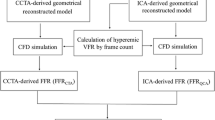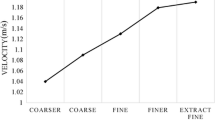Abstract
Fractional flow reserve (FFR) is an established method for diagnosing physiological coronary artery stenosis. A method for computing FFR using coronary computed tomography (CT) images was recently developed. However, its calculation requires off-site supercomputer analysis. Here, we report the preliminary result of a method using simple estimation of boundary conditions. The lumen boundaries of the coronary arteries were semi-automatically delineated using full width at half maximum of CT number profiles. The computational fluid dynamics (CFD) of the blood flow was performed using the boundary conditions of a fixed pressure at the coronary ostium and flow rates at each outlet. The total inflow at the coronary ostium was estimated based on the uniform wall shear stress hypothesis and corrected using a hyperemic multiplier to gain a hyperemic flow rate. The flow distribution from a parent vessel to the downstream daughter vessels was determined according to Murray’s law. FFR estimated by CFD was calculated as FFRCFD = Pd/Pa. We collected patients who underwent coronary CT and coronary angiography followed by invasively measured FFR and compared FFRCFD with FFR. Sensitivity, specificity, and correlations were assessed. A total of 48 patients and 72 arteries were assessed. The correlation coefficient of FFRCFD with FFR was 0.56. The cut-off value was ≤ 0.80, sensitivity was 59.1%, and specificity was 94.0%. CFD-based FFR using simple boundary conditions for on-site clinical computation provided FFRCFD values that were moderately correlated with invasively measured FFR.




Similar content being viewed by others
References
Pijls NHJ, de Bruyne B, Peels K et al (1996) Measurement of fractional flow reserve to assess the functional severity of coronary-artery stenoses. N Engl J Med 334:1703–1708. https://doi.org/10.1056/NEJM199606273342604
Pijls NHJ, van Schaardenburgh P, Manoharan G et al (2007) Percutaneous coronary intervention of functionally nonsignificant stenosis. 5-Year follow-up of the DEFER study. J Am Coll Cardiol 49:2105–2111. https://doi.org/10.1016/j.jacc.2007.01.087
Tonino PAL, De Bruyne B, Pijls NHJ et al (2009) Fractional flow reserve versus angiography for guiding percutaneous coronary intervention. N Engl J Med 360:213–224. https://doi.org/10.1056/NEJMoa0807611
De Bruyne B, Pijls NHJ, Kalesan B et al (2012) Fractional flow reserve-guided PCI versus medical therapy in stable coronary disease. N Engl J Med 367:991–1001. https://doi.org/10.1056/NEJMoa1205361
De Bruyne B, Fearon WF, Pijls NHJ et al (2014) Fractional flow reserve-guided PCI for stable coronary artery disease. N Engl J Med 371:1208–1217. https://doi.org/10.1056/NEJMoa1408758
Xaplanteris P, Fournier S, Pijls NHJ et al (2018) Five-year outcomes with PCI guided by fractional flow reserve. N Engl J Med 379:250–259. https://doi.org/10.1056/NEJMoa1803538
Tanaka N, Kohsaka S, Murata T et al (2019) Treatment strategy modification and its implication on the medical cost of fractional flow reserve-guided percutaneous coronary intervention in Japan. J Cardiol 73:38–44. https://doi.org/10.1016/j.jjcc.2018.05.018
Hirose K, Chikamori T, Hida S et al (2018) Application of pressure-derived myocardial fractional flow reserve in chronic hemodialysis patients. J Cardiol 71:52–58. https://doi.org/10.1016/j.jjcc.2017.05.007
Davies JE, Sen S, Dehbi H-M et al (2017) Use of the instantaneous wave-free ratio or fractional flow reserve in PCI. N Engl J Med. https://doi.org/10.1056/NEJMoa1700445
Liu X, Gao Z, Xiong H et al (2016) Three-dimensional hemodynamics analysis of the circle of Willis in the patient-specific nonintegral arterial structures. Biomech Model Mechanobiol 15:1439–1456. https://doi.org/10.1007/s10237-016-0773-6
Koo BK, Erglis A, Doh JH et al (2011) Diagnosis of ischemia-causing coronary stenoses by noninvasive fractional flow reserve computed from coronary computed tomographic angiograms: results from the prospective multicenter DISCOVER-FLOW (Diagnosis of Ischemia-Causing Stenoses Obtained Via Noni. J Am Coll Cardiol 58:1989–1997. https://doi.org/10.1016/j.jacc.2011.06.066
Nakazato R, Park HB, Berman DS et al (2013) Noninvasive fractional flow reserve derived from computed tomography angiography for coronary lesions of intermediate stenosis severity results from the DeFACTO study. Circ Cardiovasc Imaging 6:881–889. https://doi.org/10.1161/CIRCIMAGING.113.000297
Nørgaard BL, Leipsic J, Gaur S et al (2014) Diagnostic performance of noninvasive fractional flow reserve derived from coronary computed tomography angiography in suspected coronary artery disease: the NXT trial (Analysis of Coronary Blood Flow Using CT Angiography: Next Steps). J Am Coll Cardiol 63:1145–1155. https://doi.org/10.1016/j.jacc.2013.11.043
Nozue T, Fukui K, Takamura T et al (2017) Effects of alogliptin on fractional flow reserve evaluated by coronary computed tomography angiography in patients with type 2 diabetes: rationale and design of the TRACT study. J Cardiol 69:518–522. https://doi.org/10.1016/j.jjcc.2016.04.014
Zarins CK, Zatina MA, Giddens DP et al (1987) Shear stress regulation of artery lumen diameter in experimental atherogenesis. J Vasc Surg 5:413–420. https://doi.org/10.1016/0741-5214(87)90048-6
Wieneke H (2004) Determinants of coronary blood flow in humans: quantification by intracoronary Doppler and ultrasound. J Appl Physiol 98:1076–1082. https://doi.org/10.1152/japplphysiol.00724.2004
Murray CD (1931) The physiological principle of minimum work: a reply. J Gen Physiol 14:445. https://doi.org/10.1085/jgp.9.6.835
Wu FZ, Wu MT (2015) 2014 SCCT guidelines for the interpretation and reporting of coronary CT angiography: a report of the society of cardiovascular computed tomography guidelines committee. J Cardiovasc Comput Tomogr 9:E3. https://doi.org/10.1016/j.jcct.2015.01.003
Abbara S, Arbab-Zadeh A, Callister TQ et al (2009) SCCT guidelines for performance of coronary computed tomographic angiography: a report of the society of cardiovascular computed tomography guidelines committee. J Cardiovasc Comput Tomogr 3:190–204. https://doi.org/10.1016/j.jcct.2009.03.004
Agatston AS, Janowitz WR, Hildner FJ et al (1990) Quantification of coronary artery calcium using ultrafast computed tomography. J Am Coll Cardiol 15:827–832. https://doi.org/10.1016/0735-1097(90)90282-T
Austen WG, Edwards JE, Frye RL et al (1975) A reporting system on patients evaluated for coronary artery disease. Report of the Ad Hoc Committee for Grading of Coronary Artery Disease, Council on Cardiovascular Surgery, American Heart Association. Circulation 51:5–40
Lee JM, Choi G, Koo BK et al (2019) Identification of high-risk plaques destined to cause acute coronary syndrome using coronary computed tomographic angiography and computational fluid dynamics. JACC Cardiovasc Imaging 12:1032–1043. https://doi.org/10.1016/j.jcmg.2018.01.023
Park JB, Choi G, Chun EJ et al (2016) Computational fluid dynamic measures of wall shear stress are related to coronary lesion characteristics. Heart 102:1655–1661. https://doi.org/10.1136/heartjnl-2016-309299
Shi C, Zhang D, Cao K et al (2017) A study of noninvasive fractional flow reserve derived from a simplified method based on coronary computed tomography angiography in suspected coronary artery disease. Biomed Eng Online 16:43. https://doi.org/10.1186/s12938-017-0330-2
Zhang JM, Zhong L, Luo T et al (2016) Simplified models of Non-Invasive fractional flow reserve based on CT images. PLoS ONE 11:1–20. https://doi.org/10.1371/journal.pone.0153070
Tu S, Barbato E, Köszegi Z et al (2014) Fractional flow reserve calculation from 3-dimensional quantitative coronary angiography and TIMI frame count: a fast computer model to quantify the functional significance of moderately obstructed coronary arteries. JACC Cardiovasc Interv 7:768–777. https://doi.org/10.1016/j.jcin.2014.03.004
Leuprecht A, Perktold K, Kozerke S, Boesiger P (2002) Combined CFD and MRI study of blood flow in a human ascending aorta model. Biorheology 39:425–429
Torii R, Wood NB, Hadjiloizou N et al (2009) Fluid-structure interaction analysis of a patient-specific right coronary artery with physiological velocity and pressure waveforms. Commun Numer Methods Eng 25:565–580. https://doi.org/10.1002/cnm.1231
Author information
Authors and Affiliations
Corresponding author
Ethics declarations
Conflicts of interest
None of the authors have anything to declare regarding this article. This study was conducted as a part of the project focused on creation of medical arts by Japan Agency for Medical Research and Development (Grant Number JP17hk0102035).
Research involving human participants and/or animals
All procedures performed in studies involving human participants were in accordance with the ethical standards of the institutional research committee and the 1964 Helsinki Declaration and its later amendments or comparable ethical standards.
Informed consent
The need for written informed consent was waived because of the study’s retrospective design.
Additional information
Publisher's Note
Springer Nature remains neutral with regard to jurisdictional claims in published maps and institutional affiliations.
Rights and permissions
About this article
Cite this article
Yoshikawa, Y., Nakamoto, M., Nakamura, M. et al. On-site evaluation of CT-based fractional flow reserve using simple boundary conditions for computational fluid dynamics. Int J Cardiovasc Imaging 36, 337–346 (2020). https://doi.org/10.1007/s10554-019-01709-3
Received:
Accepted:
Published:
Issue Date:
DOI: https://doi.org/10.1007/s10554-019-01709-3




